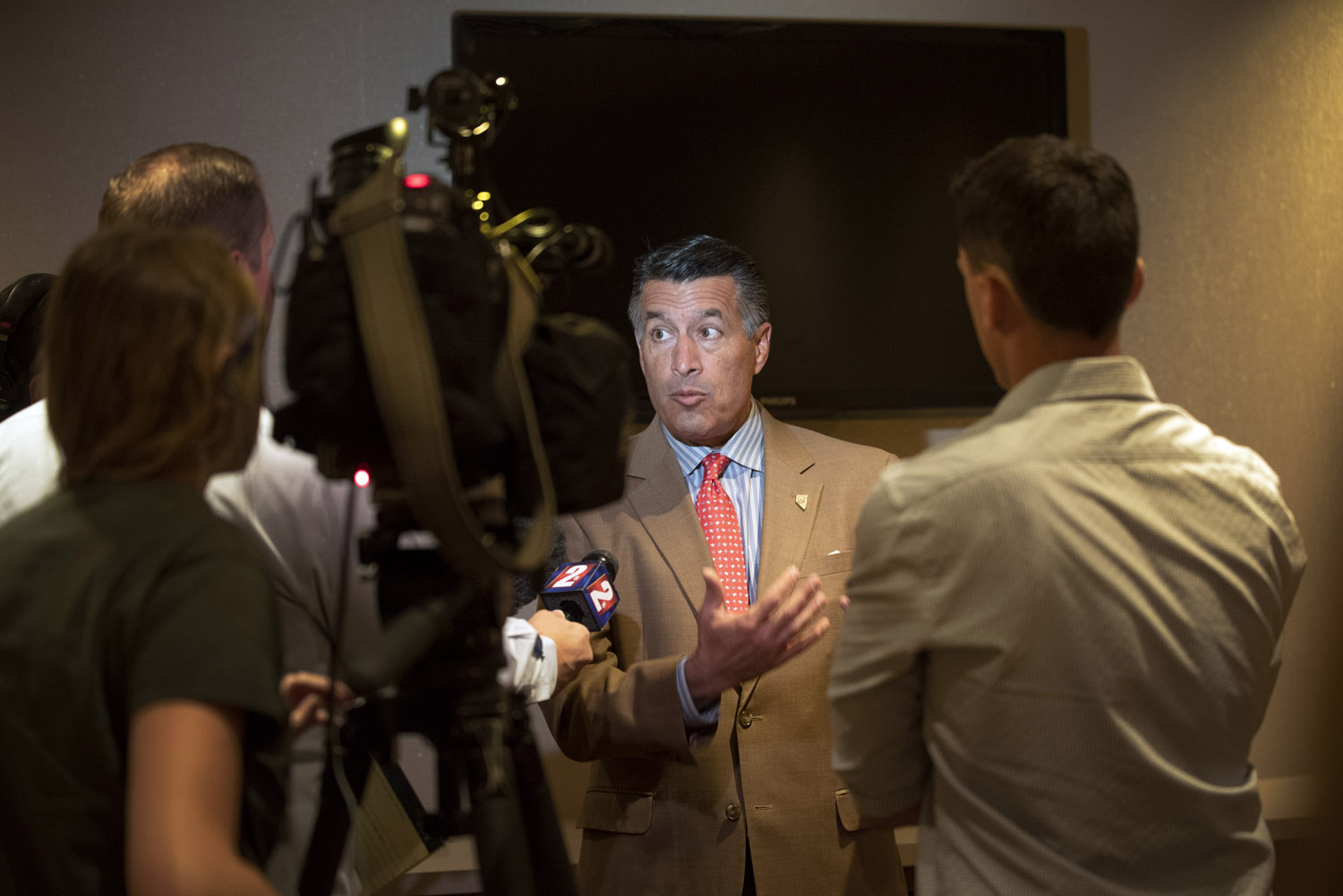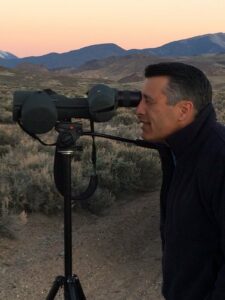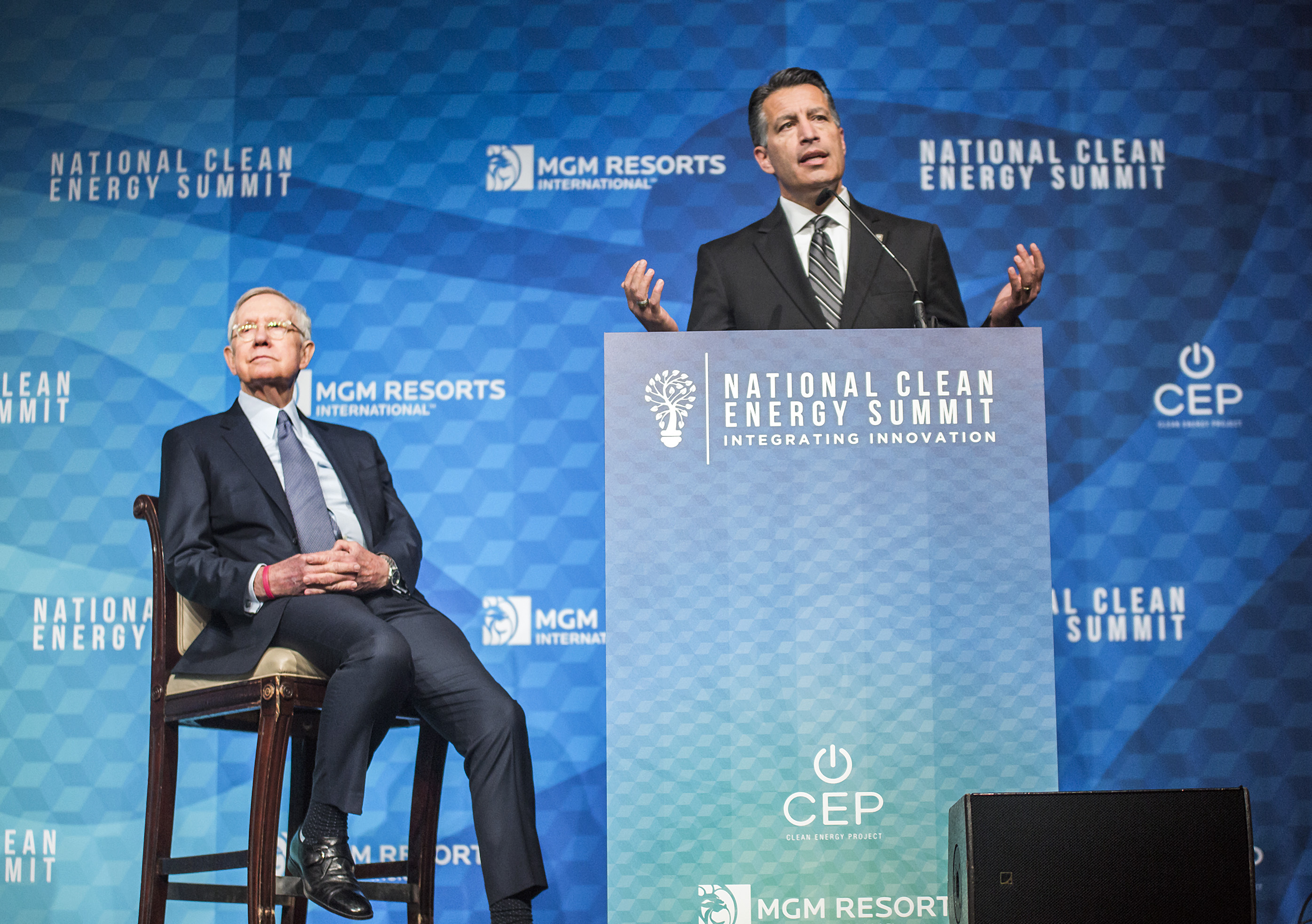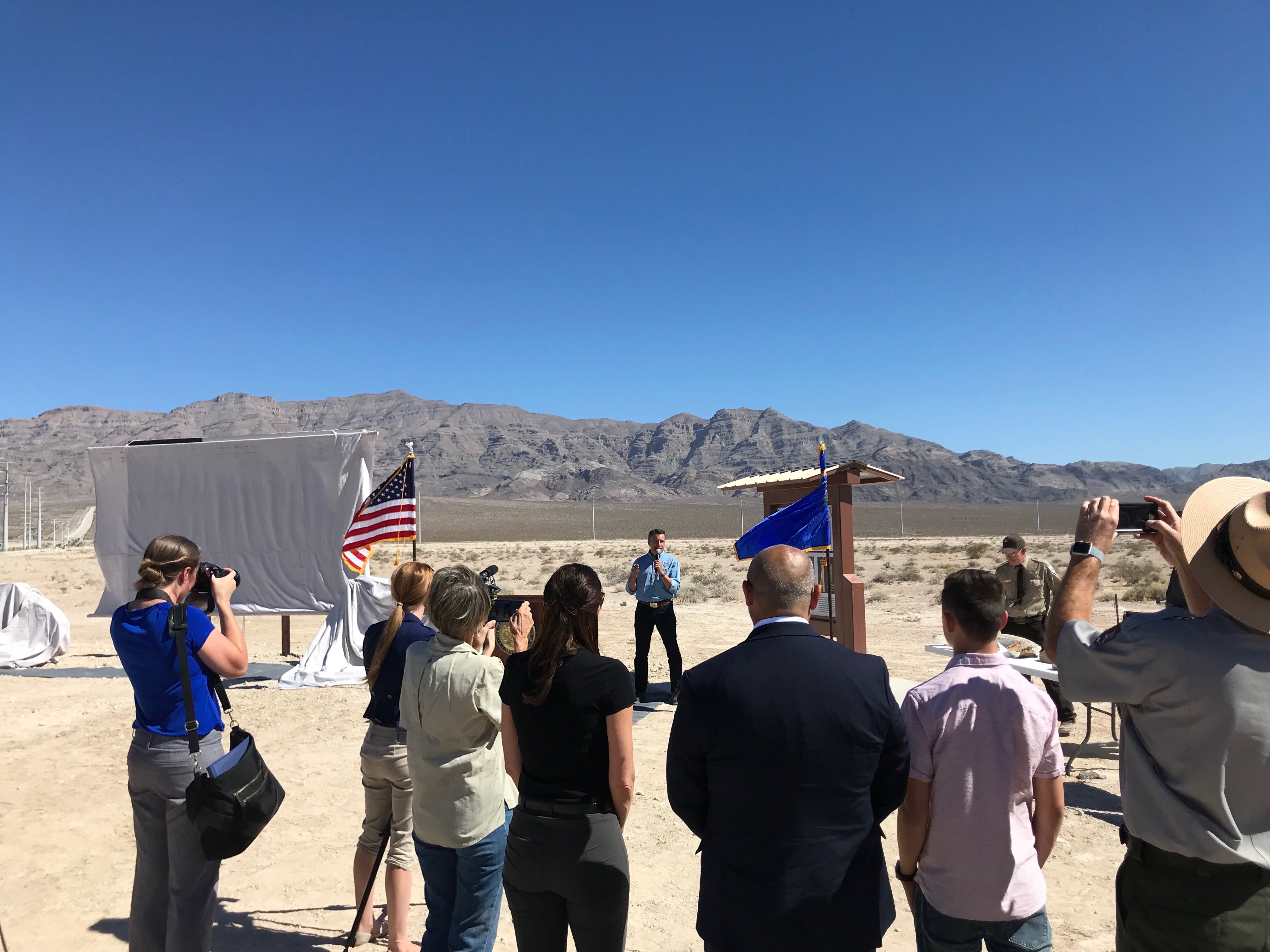Fourth of a five-part series examining outgoing Gov. Brian Sandoval’s legacy in politics, health care, economic development, education and the environment.
The get-along governor was not afraid to show his teeth.
When he convened cabinet meetings, Gov. Brian Sandoval, whose second term ends Monday, would tell his top advisers that if they were pleasing everyone, they were lying to someone, recalled Tony Wasley, who serves as the director of the Nevada Department of Wildlife.
“He wasn't afraid, as he put it, to show a little fang once in awhile," Wasley said.
In the nation’s driest state — with more than 85 percent of its land managed by the federal government — issues related to energy and the environment often pose a Gordian knot for policymakers. Nearly every land issue, from citing a renewable energy project to protecting an endangered species, involves an exhaustive list of interests: cities, ranchers, tribes, miners, environmentalists, farmers, hunters, regulators, federal land managers and at times, Congress.
Oftentimes, no one is wholly happy with the outcome of these complex, acronym-laden issues, which typically become the subject of lengthy lawsuits and are reduced to campaign rhetoric. In other words, they can be dangerous territory for politicians should they poke the wrong group.
“Politics are politics,” Wasley said in a recent interview. “However the governor always pursued what he felt was not only right but also [what he felt] was best for the state of Nevada."
Sandoval’s tenure was marked by debates over perennial issues for Nevada: water, land and development. The governor entered the fray in arguments over rooftop solar, siting renewable energy projects, public land expansions, grazing rights, drought policy, and controversial rules to protect the sage grouse, an imperiled bird that reflects the tension between development and conservation. If there was a lodestar to Sandoval’s approach on energy and land issues, his top aides said it was to ensure a balance between economic interests and the environment.
He was a pragmatist, they said, and not an ideologue.
At times, this approach has rankled groups on both sides of the spectrum. Environmentalists were frustrated with Sandoval over his initial silence in the rooftop solar debate, his veto of a renewable portfolio standard bill and his administration’s recent proposal to release about 500,000 acres of wilderness study areas for potential development. At the same time, many exploration geologists and rural counties took issue with the governor’s support for land restrictions to protect the sage grouse, which prompted a lawsuit from the attorney general.
But despite the criticism from both sides, his top aides said he did his homework — and he made the decision he felt was right, even if it meant reversing a prior policy position.
“He’s not a micromanager,” said Leo Drozdoff, the governor’s former director of the Department of Conservation and Natural Resources. “But he knows his stuff.”

A sage grouse plan for Nevada
On Sept. 22, 2015, Sandoval joined two Democratic Western governors and Wyoming Gov. Matt Mead, a fellow Republican, at the Rocky Mountain Arsenal National Wildlife Refuge in Colorado. The occasion was to announce a deal between the Obama administration and a group of bipartisan Western governors to keep the sage grouse from being listed under the Endangered Species Act if the states agreed to impose voluntary conservation measures. Sandoval had argued that allowing the bird to slip onto the list would halt mining and energy projects across the state, devastating rural economies. The sage grouse range encompasses most of the state. Accepting voluntary measures, he said, was a better long-term approach.
“He knew the consequences of inaction,” Drozdoff said.
But the plans immediately drew ire, including from Republican Attorney General Adam Laxalt who signed the state onto a lawsuit challenging the plans Sandoval had said he supported.
Sandoval said, at the time, that Laxalt was operating in his “personal capacity,” but the move reflected a broader divide between Sandoval and his own party on the sage grouse issue.
The Las Vegas Review-Journal reported that all the Republican members of the congressional delegation hailed the lawsuit. That rift would continue with the election of Donald Trump, whose administration has attempted to undo parts of the Obama-era plan and other land protections.
But where some rifts are canyons and others are gullies, this was somewhere in-between.
As a spokeswoman for Sandoval noted at the time of the plan’s release, the governor remained concerned about the land restrictions in the original plan. And Sandoval has supported some aspects of the Trump administration’s changes to the original Obama-era plans. For instance, Sandoval’s office said it supported more flexible grazing and the removal of certain habitat designation as focal areas that had limited what activities could take place on public land.
Where Sandoval has remained steadfast is in advocating for rules specific to Nevada.
The 2015 planning process allowed states to develop specific blueprints for conserving sage grouse. And Nevada chose a free-market approach, whereby companies that wanted to develop on sage grouse habitat could offset their impacts by purchasing credits for restored habitat. The Conservation Credit System — a form of mitigation — was a key part of the state plan, but it came under threat when the Trump administration removed mitigation rules earlier this year.

In an interview with The Nevada Independent in September, Sandoval said he had concerns about the Trump administration's approach since it negated the long process of bringing groups — ranchers, miners, hunters — together to agree on a sage-grouse strategy before 2015.
“We’re able to demonstrate that [the program] is working,” he said. “Don’t take something away that is working. And it took a long time to negotiate that with the mining industry and now the mining industry is a full partner in that regard. That was the point. To preserve the bird, to preserve the landscape and allow a very important industry in our state to continue.”
Since then, the governor’s office has negotiated with the Department of Interior to continue using the state plan, winning a big concession in a draft document in December. A few days later, Sandoval issued an executive order asking the state’s Sagebrush Ecosystem Council to implement Nevada’s plan by creating requirements for developers to mitigate their impact for sage grouse, requirements that the Trump administration had previously repealed.
Wasley called the executive order a “capstone” of Sandoval’s efforts on the issue.
“I really think that shows his desire to provide both business certainty — for industry’s operating on Nevada’s landscape — as well as conservation assurances for the bird,” Wasley said.

The double-edged sword of deliberation
For those who watched the Sandoval administration, what the sage-grouse debate exemplified was the governor’s desire to bring together varying interest groups to discuss a complex topic. It also showed Sandoval’s commitment to a multi-step process, rather than to one quick decision.
In 2012, after the sage grouse inched closer to a listing under the Endangered Species Act, Sandoval created the Sagebrush Ecosystem Council to explore options for protecting the bird, and the recommendations from that group were ultimately incorporated into the Nevada plan.
“The governor, in many of the things he did in his tenure, brought together all sorts of interesting groups that might not have necessarily [talked],” said Dana Bennett, the president of the Nevada Mining Association who was involved in negotiating the sage grouse plans.
Many said the governor often used his affable nature and his knowledge of issues to his advantage, personally meeting with whomever he had to influence. Drozdoff said this was evident early on in his term, when the governor, as Drozdoff put it, faced two choices: pull out of the bi-state Tahoe compact or advocate for changes to ease development restrictions.
After Nevada threatened to withdraw from the agreement with legislation in 2011 without the development of a new regional plan, Sandoval and Gov. Jerry Brown came together in 2013 to ensure they improved the compact while continuing a collaborative approach to Tahoe issues. During the 2013 session, Drozdoff noted that Sandoval personally met with California legislators during a trip to California, the kind of touch that helped the Nevada governor negotiate.
“They took great comfort that they heard from him directly,” Drozdoff said.
But during his tenure, the governor’s deliberative and thoughtful approach, an asset for creating policy, sometimes worked against him in a fast-moving public arena where everything is politics.
Nowhere was this more apparent than the debate over rooftop solar. The messy back-and-forth between rooftop solar companies and NV Energy over the value of an emerging technology garnered national headlines, seeping into the presidential race as Hillary Clinton weighed in. Others, from Tesla CEO Elon Musk to actor Mark Ruffalo, who spoke at a regulatory meeting, chimed in, too.
As hard as Sandoval tried to stay out of it, solar companies brought him into the debate. Caught in the middle was a governor who deferred to a process underway in the Public Utilities Commission, which regulates the utility and decides how much it should reimburse solar customers for sending excess electricity to the grid under a system known as “net metering.”
A vice president for policy at rooftop solar company Sunrun slammed the governor for his close relationship with top NV Energy lobbyists. The company sued for text messages between the governor’s office and NV Energy. A spokeswoman for the governor’s office fired back, telling Nevada Independent Editor Jon Ralston the claims were “uninformed, false and outrageous.”
At issue was a decision by the utilities commission, a governor-appointed regulatory panel, to reduce the value of credits NV Energy had to pay to rooftop solar customers starting in 2016. Solar companies slammed the commissioners — and the governor who appointed them — for cozying up to the utility. The governor, a former judge and attorney general who had experience in energy as a former lawyer for utility shareholders, said he would not interfere with the ruling.
As a result, the solar industry hammered the governor in public for the next five months. Sunrun and SolarCity stopped doing business in Nevada, leading to the loss of hundreds of jobs.
During those months, the conflict between NV Energy and rooftop solar firms (dubbed the “solarcoaster” by some) escalated as the utilities commission dug in and the governor’s office continued to publicly maintain its commitment to letting the regulatory process play out.
But that started to change in March, as the governor pivoted to a collaborative public process similar to the one used to come to an agreement over how to protect sage grouse habitat. At that point, the governor’s office became more actively involved in diffusing the situation.
“My view is that he did what was appropriate,” said Rose McKinney-James, a former utility commissioner and a rooftop solar lobbyist involved in the negotiations. “The debacle around rooftop solar was extremely frustrating, and it was a very difficult time for us from a regulatory standpoint. When they let us down, to his credit, he intervened. And that intervention is what put the rooftop solar issue back on track by identifying new regulatory leadership to revisit it."
Sandoval empaneled the New Energy Industry Task Force in 2016 to explore legislation to modernize Nevada’s electric grid and fix elements of the commission’s rooftop solar decision. At the task force’s first meeting, Sandoval aide Dale Erquiaga acknowledged that months of criticism over the issue had damaged the state's reputation as a leader in clean energy.
“We would like your advice on how we move beyond that,” Erquiaga said.
Not only had the rooftop solar fight hurt Nevada’s reputation, it had also left an opening for businesses to pursue the Energy Choice Initiative to dismantle NV Energy’s monopoly.
Around the same time that the task force started meeting, Sandoval met with the CEO of Sunrun, which agreed to drop its lawsuit. Over the summer of 2016, his office also tried to broker a deal between NV Energy and solar companies that ultimately fell apart.
But Sandoval’s biggest move came in September when he orchestrated a shake-up of the utilities commission, arguing that it needed “a fresh perspective and new direction.”
"The commission took action,” said Paul Thomsen, the chair of the utilities commission during the rooftop solar debate and a former energy aide for Sandoval. “It wasn't popular. And I think the governor stepped in when he felt that he needed to bring balance to the debate. He commented on the commission decision and voiced support for a happy medium."
Angie Dykema, head of the Governor’s Office of Energy, started with the administration during the peak of the rooftop solar fight, and said the issue was a challenging one. The governor did not want ratepayers to pick up the cost of rooftop solar customers. But at the same time, a key priority was expanding renewables, and Sandoval wanted the rooftop solar industry to remain.
“He wanted that message to be loud and clear,” she said. “And it got kind of muddied, I guess.”
With new faces at the utilities commission and legislation that Sandoval signed in 2017, the governor was able to lure rooftop solar companies back to the state 18 months after they left.
“I know all the solar folks are here — I know we had a little hiccup in between all of this — but without that I honestly do believe we wouldn’t be standing here today with the success that we’re having so I really am pleased,” Sandoval said at the time of the bill signing.

A business outlook on renewables
Within the Sandoval administration, the rooftop solar debate was a frustrating blip for a governor who had emphasized clean energy at a time when many Republicans had steered away from the issue. Unlike many other Western states, Nevada does not have a thriving coal or petroleum industry. If Nevada wanted to get into energy development, it had to look toward renewables.
Sandoval recognized this, several advisers said, and he viewed clean energy development as a win-win issue: something that would be good for the economy and good for the environment.
Under the Sandoval administration, Dykema said the state saw $7.8 billion in total investment, including capital, payroll and taxes, for new renewable projects. At the same time, the state issued about $861 million in tax abatements to help get renewable energy projects off their feet.
“It was more of an economic development focus,” Dykema said. “His approach to it was [that the state really needed] to embrace these emerging technologies, like distributed energy resources, electric vehicles and rooftop solar. We [needed] to be on the forefront of that and embrace them."
Sandoval, a pragmatic politician, worked across the aisle to achieve many of those goals.
He came together with then-Senate Majority Leader Harry Reid to support the early closure of the coal-fired Reid Gardner Generating Station near Moapa. The ensuing bill in 2013 to close the power plant shifted the state away from imported coal and pointed it in the direction of renewables with the inclusion of a clean energy requirement for NV Energy.
One year later, Sandoval, working with Brown in California, filed a letter with federal regulators supporting the expansion of a regional Energy Imbalance Market to better integrate solar into the power grid. Thomsen, who worked for Sandoval at the time, cited the move as an example of the governor’s ability to work across party lines and broker deals with Democratic governors.
By 2017, 18 percent of the energy generated in the state came from renewables, including solar and geothermal, doubling from the amount produced when Sandoval took office in 2010. About 72 percent comes from natural gas and a sliver — only 7 percent — came from coal, according to the state’s 2017 energy status report. Nevada also benefited from its close proximity to California, with strong renewable goals, exporting new energy to users outside of the state.
Exporting energy, Dykema noted, “is still a win for Nevada.”
Most rooftop solar companies and large-scale solar developers came to Nevada from other states. When it comes to renewables, the expertise of Nevada-headquartered companies largely lies in the one renewable source that is often left out of the conversation: geothermal.
During his tenure, Sandoval actively worked to boost the state’s geothermal industry. His administration helped push for a national geothermal laboratory, pledging $1 million to the effort in November 2017. The state ultimately lost the $140 million in grant dollars to Utah.
The governor’s office worked to support geothermal, which uses the Earth’s heat to produce power, in other ways too. As part of the negotiations with the Navy over an expansion of its air station in Fallon, Sandoval proposed removing wilderness-like protections to offset the impacts on geothermal development from the military’s proposed closure of about 700,000 acres of land.
This move frustrated conservationists, who have argued that it would be possible to promote geothermal without pulling back protections for about 500,000 acres of Wilderness Study Areas.
Environmentalists supported Sandoval on clean energy, but many felt he didn’t go far enough.
While Democratic governors cast their clean energy priorities under the umbrella of climate change, Sandoval avoided using the term for most of his tenure. Instead, he preferred to argue renewables were good for jump-starting the economy, noting their environmental benefits.
“He talks about it as being good for the economy,” said Brad Crowell, who currently leads the Department of Conservation and Natural Resources. “In this case, being good for the economy is being good for the environment as well. That doesn’t escape him by any means.”
In a recent interview with The Nevada Independent, Sandoval said his record around energy and creating the state’s electric highway has worked to reduce the impact of climate change.
“I’ve never denied that there’s climate change, and I think what’s more important than answering whether you believe in it or not is what your actions are,” he said. “So I think that Nevada has done a lot of things with my encouragement and signing and sponsoring laws.”
Reid, in an interview, noted that Sandoval regularly participated in or helped host his annual clean energy summits in Las Vegas unless there was a conflict.
“[Climate change is] a tremendously difficult issue and it’s been my issue for a long long time, so I’ve been way out front on that and as far as I’m concerned, he never held me back from doing anything I wanted to do,” Reid said.
Andy Maggi, who runs the Nevada Conservation League, said Sandoval’s environmental record was solid but his record fell short of what it could have been after he vetoed legislation to increase the state’s Renewable Portfolio Standard and community solar bill in 2017.
“For whatever reason, he was never able to go all in,” Maggi said. “So I feel like there were some missed opportunities as well. He left some things on the table that would have really solidified his legacy, not just as a governor who was good on clean energy, but a champion.”
At the time, Sandoval said he vetoed the bill to increase Nevada’s renewable energy portfolio to 40 percent by 2030 because of the uncertainty created by Question 3, the effort to strip NV Energy of its monopoly on the state’s energy supply. The ballot measure failed in November.
Without Question 3 in the mix, Dykema said “it would have been a completely different story.”
Sandoval recently told The Nevada Independent that he supports increasing the standard.
“Yes, I want there to be a more aggressive renewable portfolio standard and now the next governor, the next Legislature will have the benefit of knowing there is not going to be energy choice and they’ll have a lot less issues that are complicating that,” he said.

Managing federal land
When the governor first came to office, Drozdoff recalled a number of wildfires hitting Northern Nevada. In 2012, about 10,000 people were evacuated in Washoe County because of a fast-moving 3,000 acre fire. As a governor, Sandoval took his role as a fire manager seriously, Drozdoff said.
“He was very moved by fires early in his governorship,” Drozdoff said.
In the basins that pockmark Nevada, the increasing intensity of wildfire remains one of the most potent threats to activities that take place on the state’s public land, from grazing to hunting. But what complicates fire management for the state is the fact that more than 85 percent of land in Nevada is managed by the federal government. This was a fact Sandoval mentioned frequently, and his advisers said he encouraged his staff to work closer with their federal counterparts.
This issue resurfaced last year when Nevada saw the worst single fire in state history. In total, just two fires last year burned more than 1 million acres in Nevada, destroying grazing land for ranchers, habitat for threatened species like the sage grouse and recreation opportunities.
In September, Sandoval told reporters that the federal government could do more to help fighting fires by tilting the balance from a sole focus on fighting fires to fire prevention.
“It takes a lot of time and it takes a lot of management,” he said. “Nevada is 86 percent federal land so the federal government has a very big and important responsibility to do the right thing.”
As with any Nevada governor, the push-and-pull between the state and the federal government was one dynamic that defined Sandoval’s tenure on a laundry list of land management issues.
During his time in office, the Obama administration designated two national monuments: Gold Butte and Basin and Range. When the Basin and Range National Monument was designated, Sandoval criticized the process for bypassing Congress and excluding some stakeholders.
But his response was largely neutral. And again, in 2016, when the Obama administration designated Gold Butte National Monument, Sandoval offered only a tepid response where in states like Utah, Republican governors came out swinging against monument designations.
In part, this was due to Sandoval’s approach: to deal with the political reality as it was.
After the creation of Gold Butte, Sandoval said that once he “recognized the inevitability of this designation,” he said his focus shifted to mitigating its impact on local communities. It was also the result of his relationship with Reid and a strategy to neutralize Sandoval on the issue.
As part of the campaigns for both monuments, a coalition including former Reid staffer Megan Jones built popular support for the designations among businesses and the broader public. As the designation neared, protecting Gold Butte became a popular cause because of its proximity to the Bundy Ranch, the site of an armed standoff between scofflaw rancher Cliven Bundy and the Bureau of Land Management (BLM) over Bundy’s decades-long refusal to pay grazing fees.
A monument designation became increasingly inevitable, Sandoval worked with Reid and the White House to address his concerns, such as adjusting the proposed monument boundaries to protect private land and ensure that activities like hunting and off-road recreation could occur.
"Without Senator Reid and Governor Sandoval's partnership, in some way shape or form, we would not have two monuments in the state of Nevada,” said Jones, a partner at Hilltop Public Solutions.
When the Trump administration considered reviewing the national monuments, Sandoval told the Reno Gazette Journal he supported small adjustments to Gold Butte National Monument. President Trump’s former Interior Secretary Ryan Zinke recommended reductions in the size of the monument, but not to make wholesale changes, as it did in places like Utah.
"The reason we didn't see [large changes] in the final recommendations was probably due to a lot of quiet negotiations" involving the Sandoval administration, Jones said.
The Gold Butte designation, in part, also bookmarked a chapter in the Bundy saga, the state’s most recent brush with the Sagebrush Rebellion, a movement that sprung up in the 70s among Western ranchers who wanted control of federal public land placed in the hands of the state.
As the BLM began rounding up cattle at the Bundy Ranch but before the conflict escalated into an armed standoff, Sandoval, Sen. Dean Heller and several other elected officials criticized what they saw as the BLM’s excessive tactics in resolving the dispute over cattle ranching.
“No cow justifies the atmosphere of intimidation which currently exists nor the limitation of constitutional rights that are sacred to all Nevadans,” Sandoval said in a statement before the standoff. “The BLM needs to reconsider its approach to this matter and act accordingly.”
Patrick Donnelly, state director of the Center for Biological Diversity, said he rejected the idea that the governor was “moderate” on the environment, especially when it came to public land.
“The Sandoval administration has been a mixed bag for the environment,” he said. “But on the whole, I think he's taken several actions that are detrimental to the future of our public lands."
Donnelly cited Sandoval’s willingness to support any reductions to Gold Butte and the state’s decision to defer a Superfund listing for a former copper mine near the Yerington Paiute Tribe reservation as ways in which Sandoval set what could be slippery precedents for land policy.
Sandoval had to reckon not only with a Nevada constant — federal land ownership — but he was also forced to deal with extreme drought that sapped water resources across the state.
In 2015, Sandoval empaneled a Drought Forum that explored ways to prepare Nevada for future droughts under the strict rules of Western water law. The forum recommended changes to Nevada water law, but many of them are controversial and the legislature did not act on them in the last session. The Department of Conservation and Natural Resources has proposed bills for the upcoming legislative session. They are expected to meet pushback from a broad coalition.
“The Drought Forum and the recommendations that came out of that, I think are a real legacy for the state,” Crowell said. “I think it’s incumbent upon [the Legislature] now to help us enact some of those recommendations from the drought forum so we are actually prepared for the next drought, not just saying ‘we’re not in a drought now so we don’t have to worry about it.'”
Sandoval also chose drought as his focus during his chairmanship of the Western Governors Association, displaying what Drozdoff described as his desire to tackle issues in many venues.
Jim Ogsbury, the executive director of the association, said Sandoval approached the issue from a state-driven perspective, creating a framework for the organization's future policy work.
"He established the template and model for nearly all of the initiatives that have followed."
When Crowell, who came from the Obama administration, first took the job with Sandoval, he said he recognized that the two saw eye-to-eye on the value of the outdoors. This came through in the governor’s commitment to creating two new state parks: the Ice Age Fossils State Park and the Walker River State Recreation Area. Crowell and Drozdoff said Sandoval prided himself on his commitment to the state park system, becoming the only governor to visit all of the parks.
“It’s something he wore with pride,” Drozdoff said.
Nevada Independent reporter Michelle Rindels contributed to this report.